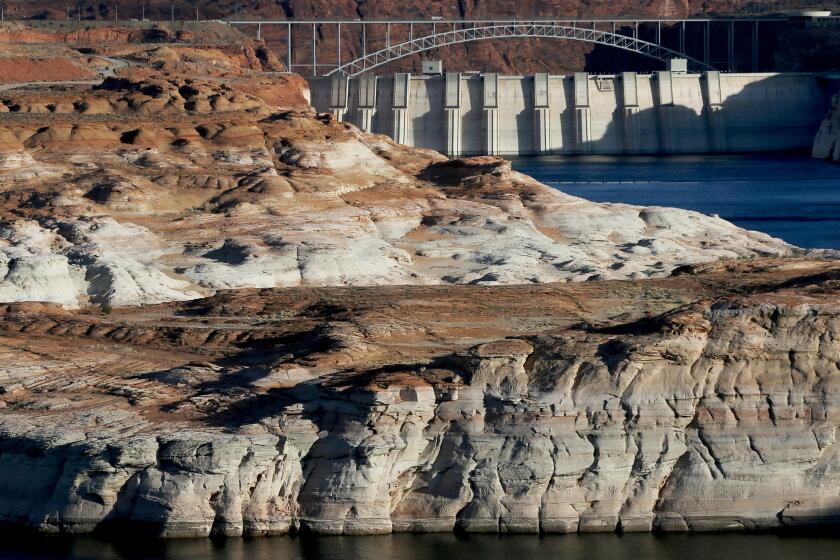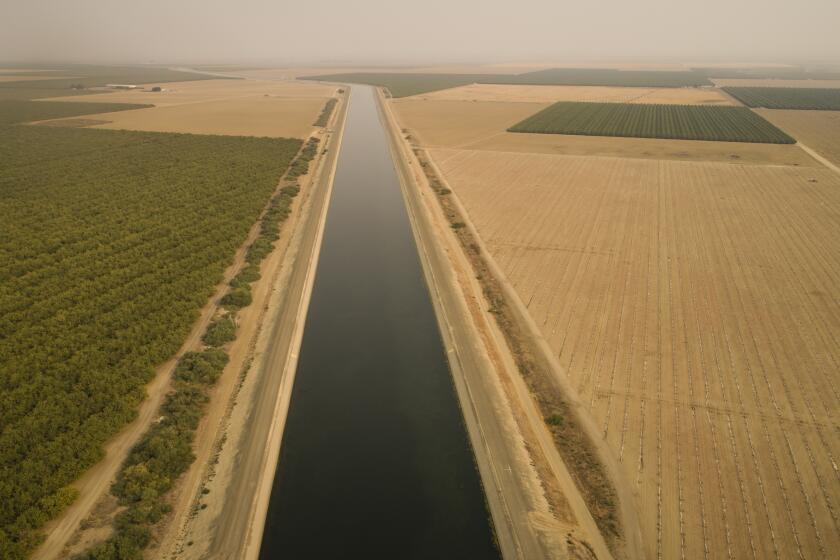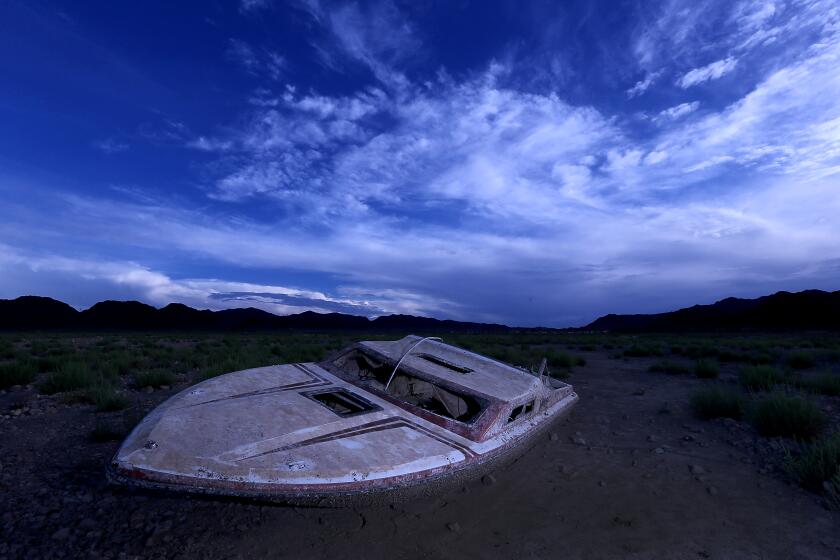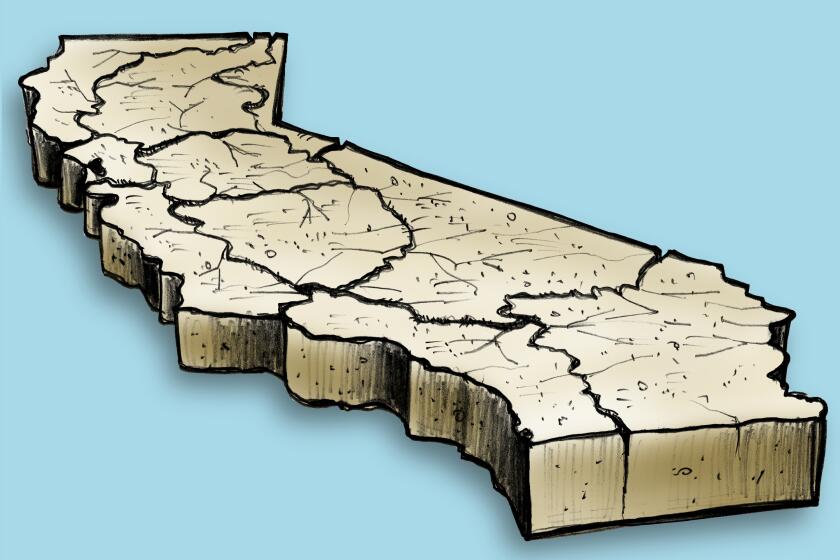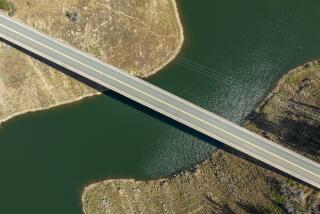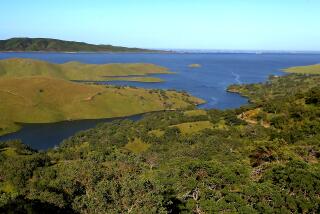Drought emergency declared for all Southern California

- Share via
As California faces the prospect of a fourth consecutive dry year, officials with the Metropolitan Water District of Southern California have declared a regional drought emergency and called on water agencies to immediately reduce their use of all imported supplies.
The decision from the MWD’s board came about eight months after officials declared a similar emergency for 7 million people who are dependent on supplies from the State Water Project, a vast network of reservoirs, canals and dams that convey water from Northern California. Residents reliant on California’s other major supply — the Colorado River — had not been included in that emergency declaration.
“Conditions on the Colorado River are growing increasingly dire,” MWD Chairwoman Gloria Gray said in a statement. “We simply cannot continue turning to that source to make up the difference in our limited state supplies. In addition, three years of California drought are drawing down our local storage.”
Officials said the call for conservation in Colorado River-dependent areas could become mandatory if drought conditions persist in the coming months, which some experts say is likely. By April, the MWD will consider allocating supplies to all of its 26 member agencies, requiring them to either cut their use of imported water or face steep additional fees. The agencies together serve about 19 million people.
Colorado River reservoirs are dropping amid drought and climate change. The Biden administration has announced new measures to address the crisis.
“Since this drought began, we have been steadily increasing our call for conservation. If we don’t have an extremely wet winter, we will need to elevate to our highest level — a water supply allocation for all of Southern California,” said MWD General Manager Adel Hagekhalil. “Substantial and immediate conservation now and in the coming months will help lessen the potential severity of such an allocation.”
MWD member agencies, which include the Los Angeles Department of Water and Power, the Municipal Water District of Orange County and the Inland Empire Utilities Agency, will implement voluntary and mandatory conservation measures at the local level based on their particular circumstances, officials said. Those with local supplies or other alternative options may be able to rely on them in the interim.
The DWP, which imports state and federal water as well as water from the Owens Valley via the Los Angeles Aqueduct, has been under Level 3 of its water shortage contingency plan since June, including two-day-a-week outdoor watering limitations.
During a board meeting Tuesday, DWP senior assistant general manager Anselmo Collins said MWD’s decision was “setting the stage” for the entire region to see similar rules should the Colorado order become mandatory.
“We already have a budget that’s been given to us, so to us [in Los Angeles] it’s probably not going to be any different,” he told the board. “It is going to be for the other 20 member agencies that are currently not under a water supply allocation. ... They would too be put on some kind of volumetric budget, or one-day-a-week requirement.”
The Department of Water Resources announced an initial allocation of just 5% of requested supplies from the State Water Project.
About half of the MWD’s imported water comes from the State Water Project and half from the Colorado River — both of which have become “extraordinarily stressed by prolonged drought exacerbated by climate change,” the agency said.
The Colorado River has fallen to such historic lows that Lake Mead and Lake Powell — the nation’s two largest reservoirs — could reach “dead pool”, or the point at which water no longer passes downstream from a dam. California and six other states that rely on the river have been under pressure from the federal government to drastically reduce their use.
In October, some California water agencies, including the MWD, pledged usage reductions of up to 400,000 acre-feet per year, or about 9% of the state’s total 4.4 million water allotment from the river, through 2026. Still, other states are demanding that California do more to cut usage.
The drought emergency declaration came as representatives of the MWD and other water districts gathered in Las Vegas with officials from all seven states, the federal government and tribes for the annual conference of the Colorado River Water Users Assn. Attendees are discussing various issues about how the river is managed, including measures to address the severe shortage.
“It’s a good step for sure,” conference attendee Daryl Vigil, water administrator of the Jicarilla Apache Nation in New Mexico, said of the MWD’s declaration.
The willingness of the district’s officials to “take part in mitigating the risk in terms of reduction in use is really big coming from California,” Vigil said. “And hopefully others will follow suit.”
Scott Houston, vice president of the West Basin Municipal Water District, a wholesale supplier for nearly 1 million people in 17 cities and unincorporated areas in Los Angeles County, said the move is necessary.
“We are in a critical time with the Colorado River,” Houston said. “This is a very serious situation, as we’ve seen the conditions escalate over the last few months. This is an all-hands-on-deck moment.”
As reservoirs decline on the Colorado River, California water agencies are under pressure to shoulder a substantial part of the inevitable cuts.
The State Water Project has been under similar strain. The driest three water years on record in California resulted in record-low deliveries to Southern California, and earlier this month, state officials said they may allocate only 5% of requested supplies next year if drought conditions do not significantly improve.
Madelyn Glickfeld, co-director of the UCLA Water Resources Group, said the MWD’s decision was a “warning shot” for what could lie ahead — and a reminder of how important it is for communities to invest in alternative supplies such as recycled water and, in some cases, groundwater and desalination.
“We’ve been working hard toward this, but I don’t think anyone expected — or they didn’t look carefully enough — to expect that this was going to happen right now,” she said. “There were a lot of places where people could have taken the warning before now, but they have not.”
The latest maps and charts on the California drought, including water usage, conservation and reservoir levels.
The MWD underscored that it has been making big investments in sustainable local supplies for the region, including the development of what could be one of the world’s largest recycled water facilities, Pure Water Southern California.
But many such projects are years if not decades away, and action is critical now, Glickfeld said. For the time being, conservation and “a complete transition in the way we do landscaping” are among the region’s best bets.
Indeed, many agencies, including the DWP and the West Basin Municipal District, have been offering rebates for residents to replace their grass with drought-resilient landscaping.
“One of the biggest areas where we use water is outdoor irrigation,” Houston said. “That’s really one of the best tools in our toolbox right now to reduce the need for some of that imported water.”
As officials continue to weigh their options for the Colorado River, the mandatory measures in State Water Project-dependent areas will continue through at least June and possibly longer, the MWD said.
“Some Southern Californians may have felt somewhat protected from these extreme conditions over the past few years,” Gray said. “They shouldn’t anymore. We are all affected.”
